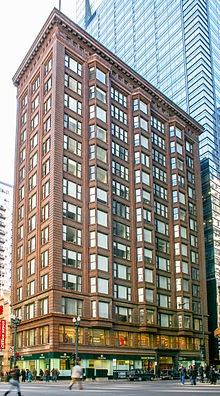Chicago's architecture is famous throughout the world and one style is referred to as the Chicago School. The style is also known as Commercial style.[1] In the history of architecture, the Chicago School was a school of architects active in Chicago at the turn of the 20th century. They were among the first to promote the new technologies of steel-frame construction in commercial buildings, and developed a spatial aesthetic which co-evolved with, and then came to influence, parallel developments in European Modernism. A "Second Chicago School" later emerged in the 1940s and 1970s which pioneered new building technologies and structural systems such as the tube-frame structure.[2]
 First Chicago School
First Chicago School
[edit]
While the term "Chicago School" is widely used to describe buildings in the city during the 1880s and 1890s, this term has been disputed by scholars, in particular in reaction to Carl Condit's 1952 book The Chicago School of Architecture. Historians such as H. Allen Brooks, Winston Weisman and Daniel Bluestone have pointed out that the phrase suggests a unified set of aesthetic or conceptual precepts, when, in fact, Chicago buildings of the era displayed a wide variety of styles and techniques. Contemporary publications used the phrase "Commercial Style" to describe the innovative tall buildings of the era rather than proposing any sort of unified "school".
Some of the distinguishing features of the Chicago School are the use of steel-frame buildings with masonry cladding (usually terra cotta), allowing large plate-glass window areas and limiting the amount of exterior ornamentation. Sometimes elements of neoclassical architecture are used in Chicago School skyscrapers. Many Chicago School skyscrapers contain the three parts of a classical column. The first floor functions as the base, the middle stories, usually with little ornamental detail, act as the shaft of the column, and the last floor or so represent the capital, with more ornamental detail and capped with a cornice.
The "Chicago window" originated in this school. It is a three-part window consisting of a large fixed center panel flanked by two smaller double-hung sash windows. The arrangement of windows on the facade typically creates a grid pattern, with some projecting out from the facade forming bay windows. The Chicago window combined the functions of light-gathering and natural ventilation; a single central pane was usually fixed, while the two surrounding panes were operable. These windows were often deployed in bays, known asoriel windows, that projected out over the street.
Architects whose names are associated with the Chicago School include Henry Hobson Richardson, Dankmar Adler, Daniel Burnham, William Holabird, William LeBaron Jenney, Martin Roche, John Root, Solon S. Beman, and Louis Sullivan. Frank Lloyd Wright started in the firm of Adler and Sullivan but created his own Prairie Style of architecture.
The Home Insurance Building, which some regarded as the first skyscraper in the world, was built in Chicago in 1885 and was demolished in 1931. Some of the more famous Chicago School buildings include:
Chicago school (architecture) - Wikipedia, the free encyclopedia
en.wikipedia.org/wiki/Chicago_school_(architecture)Chicago's architecture is famous throughout the world and one style is referred to as the Chicago School. The style is also known as Commercial style. In the ...SoA@UIC/ The School of Architecture at University of Illinois Chicago
www.arch.uic.edu/The School of Architecture at the University of Illinois Chicago. p(312)996-3335 address: Rm 3100, Art and Architecture Building, 845 W. Harrison, Chicago, ...Images for chicago school of architecture
- Report imagesArchitecture: The First Chicago School - Encyclopedia of Chicago
www.encyclopedia.chicagohistory.org/pages/62.htmlIt is no mere accident that in the 1880s Chicago produced a group of architects, now known as the “First Chicago School,” whose work would have a profound ...The Chicago School of Architecture: A History of Commercial and ...
Rating: 3 - 2 reviewsThis thoroughly illustrated classic study traces the history of the world-famousChicago school of architecture from its beginnings with the functional innovations...The Chicago School of Architecture - University of Chicago Press
press.uchicago.edu/ucp/books/book/chicago/C/bo3629529.htmlThe book The Chicago School of Architecture: A History of Commercial and Public Building in the Chicago Area, 1875-1925, Carl W. Condit is published by ...Chicago School of Architecture - The Beginning of Modern ...
www.boundless.com › ... › The Beginning of Modern ArchitectureChicago School of Architecture. The Chicago School of architecture is famous for promoting steel-frame construction and a modernist spatial aesthetic. fig. 1 ...Understanding the Chicago School of Architecture - YouTube
www.youtube.com/watch?v=5H5u6vvTsmMOct 29, 2009 - Uploaded by macfoundCompleted in 1895, the Marquette Building is a ChicagoLandmark, a National Historic Landmark, and is listed ...- More videos for chicago school of architecture »
Amazon.com: The Chicago School of Architecture: A History of ...
www.amazon.com › ... › Humanities › ArchitectureThis thoroughly illustrated classic study traces the history of the world-famousChicago school of architecture from its beginnings with the functional innovations...[PDF]The Architects and the Ideas Behind the Chicago School (page 46)
www.illinoishistory.gov/Illinois%20History/Feb0446.pdfCheap." That was the motto of William Holabird, a Chicago School architect. There are many aspects to the Chicago school. The Chicago school was a style that ...Chicago School (architecture) -- Encyclopedia Britannica
www.britannica.com/EBchecked/topic/110504/Chicago-SchoolGroup of architects and engineers who, in the late 19th century, developed the skyscraper. They included Daniel Burnham, William Le Baron Jenney, John Root, .
